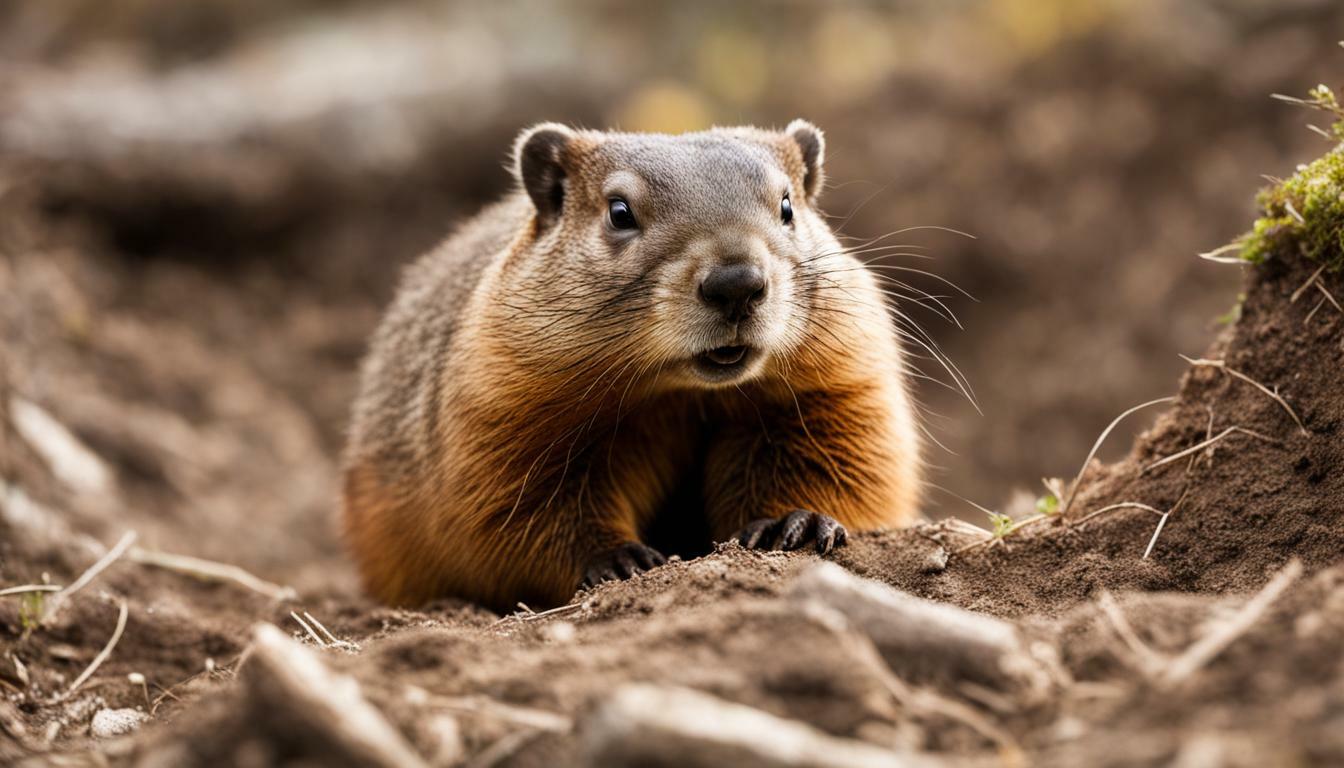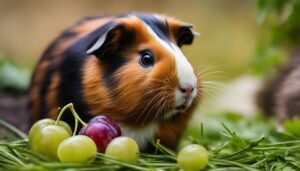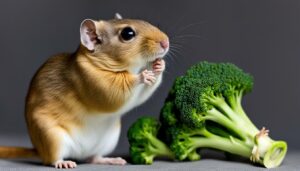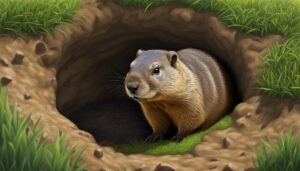Many people wonder if they can keep a groundhog as a pet, but there are several important factors to consider before making this decision. Groundhogs are challenging animals to keep as pets and are not naturally inclined to be domesticated. They have destructive habits like gnawing and digging, which can cause damage to furniture and property. Groundhogs are also difficult to train and may not be properly house trained or respond to commands. In addition, they are likely to carry diseases and parasites, making it hard to find proper veterinary care. Adopting a groundhog as a pet requires a huge commitment and rehoming them is nearly impossible. Overall, groundhogs are not suitable or recommended as pets.
Key Takeaways:
- Groundhogs are not naturally inclined to be domesticated.
- They have destructive habits like gnawing and digging.
- Groundhogs are difficult to train and may not be properly house trained or respond to commands.
- They are likely to carry diseases and parasites.
- Adopting a groundhog as a pet requires a huge commitment and rehoming them is nearly impossible.
Groundhog’s Natural Inclination
Groundhogs are wild animals and have not been selectively bred for domestication, which means they retain their natural instincts and behaviors even in captivity. As burrowing rodents, groundhogs have a strong instinct to dig and create elaborate underground dens. In a domestic setting, this can lead to destructive behavior as they attempt to dig tunnels in furniture, walls, and floors.
In addition to their digging habits, groundhogs are also known for their gnawing behavior. Like other rodents, they have continuously-growing incisor teeth that require regular gnawing to keep them at a manageable length. Unfortunately, this natural behavior can result in damage to furniture, electrical wiring, and other household items.
Groundhog’s Natural Inclination
Training a groundhog can be a significant challenge due to their innate wild nature. They are not naturally inclined to respond to commands or be house trained like traditional domestic pets. Groundhogs have a strong sense of independence and are less likely to form a bond or create a predictable routine with their human caretakers.
When considering the care of a groundhog in captivity, it is also important to address their health concerns. Groundhogs are susceptible to a range of diseases, including rabies, which can be transmitted to humans and other animals. Finding proper veterinary care for groundhogs can be difficult, as not all veterinarians are equipped to treat these unique animals.
Ultimately, keeping a groundhog as a pet requires a significant commitment. They are long-lived animals, with an average lifespan of up to 10 years. Adopting a groundhog means dedicating time, effort, and resources to provide for their specialized needs. Additionally, due to their wild nature and specific care requirements, rehoming a groundhog is nearly impossible once they have been adopted.
| Points to consider: |
|---|
| Groundhogs are not naturally inclined to be domesticated and retain their natural instincts even in captivity. |
| They have a strong instinct to dig and create underground dens, which can lead to destructive behavior in a domestic environment. |
| Groundhogs’ gnawing behavior can cause damage to furniture, electrical wiring, and other household items. |
| Training groundhogs is a challenge, as they are not naturally responsive to commands or house trained. |
| Groundhogs are susceptible to diseases, including rabies, and finding proper veterinary care can be challenging. |
| Keeping a groundhog as a pet requires a significant commitment and rehoming them is nearly impossible. |
Destructive Habits
Groundhogs have a natural instinct to gnaw and dig, which can lead to destructive behavior when kept as pets. These behaviors, while essential for their survival in the wild, can cause significant damage to furniture and property in a domestic setting. Their incessant gnawing can ruin wooden structures, wires, and even personal belongings, posing a risk to both the groundhog and the owner. Additionally, their digging habits can result in unsightly and potentially hazardous holes in the yard or garden.
It is important to note that these destructive habits are deeply ingrained in a groundhog’s nature. Attempting to suppress or redirect these behaviors through training methods can be challenging and often ineffective. Despite their cute appearance, groundhogs are not well-suited to live indoors or in confined spaces, as their need to explore and engage in natural behaviors cannot be easily satisfied.
Table 1: Potential Damage Caused By Groundhog’s Destructive Habits
| Behavior | Damage |
|---|---|
| Gnawing | Ruined furniture, wires, and personal belongings |
| Digging | Unsightly and hazardous holes in the yard or garden |
In summary, while groundhogs’ natural instinct to gnaw and dig is essential for their survival in the wild, it can lead to destructive behavior when kept as pets. These behaviors, combined with their difficulty in being effectively trained, make groundhogs unsuitable for domestication and ownership. It is important to consider these factors before deciding to keep a groundhog as a pet.
Training Challenges
Groundhogs are difficult to train due to their natural instincts and independent nature, making it challenging to teach them proper behaviors. Their natural inclination is to dig and gnaw, which can be destructive to furniture and property. These habits are deeply ingrained in their behavior and are difficult to modify.
In addition to their destructive habits, groundhogs are not easily house trained and may not respond well to commands. They are highly independent animals and prefer to roam freely in their natural habitats. Trying to confine them to a specific area or teach them obedience can be frustrating and often ineffective.
Furthermore, groundhogs have a limited attention span and may not be motivated by traditional training methods. They are not naturally inclined to please their owners or seek rewards, making it challenging to establish a bond based on positive reinforcement. Their stubborn and independent nature often leads to training sessions that are ineffective and unsuccessful.
Table 1: Training Challenges with Groundhogs
| Challenge | Description |
|---|---|
| destructive behavior | Groundhogs have a natural inclination to dig and gnaw, which can cause damage to furniture and property. |
| difficult to house train | Groundhogs are not easily house trained and may not adjust to being confined to a specific area. |
| lack of responsiveness to commands | Groundhogs have a limited attention span and may not respond well to traditional training methods. |
| lack of motivation for training | Groundhogs are not naturally inclined to please their owners or seek rewards, making training sessions challenging. |
Given these training challenges, it is not recommended to keep groundhogs as pets if one is seeking a trainable and obedient companion. Groundhogs thrive best in their natural habitats, where they can exhibit their natural behaviors and live a fulfilling life.
Health Concerns
Groundhogs, like many wild animals, can carry diseases and parasites, making it important to provide proper veterinary care, which can be challenging to find. These animals may be carriers of diseases such as leptospirosis, which can be transmitted to humans through contact with urine or bodily fluids. Additionally, groundhogs can harbor external parasites like ticks and fleas, which can pose health risks.
In the United States, finding a veterinarian with expertise in groundhog care can be difficult, as these animals are not commonly kept as pets. Groundhogs have specific dietary and health needs that may require specialized knowledge and treatment. Without proper veterinary care, it can be challenging to ensure the health and well-being of a pet groundhog.
Furthermore, caring for a groundhog as a pet requires knowledge of their dietary requirements and the potential hazards they may be exposed to in a domestic environment. Groundhogs have specific nutritional needs and require a high-fiber diet consisting of fresh vegetables, fruits, and hay. Providing the wrong diet can lead to nutritional deficiencies and related health issues.
| Health Concerns | Possible Risks |
|---|---|
| Leptospirosis | Transmission to humans through contact with urine or bodily fluids |
| External Parasites | Ticks and fleas can pose health risks |
| Nutritional Deficiencies | Providing the wrong diet can lead to health issues |
Considering these health concerns and the challenges in finding proper veterinary care, it is recommended to avoid keeping groundhogs as pets. Instead, observing these fascinating creatures in their natural habitats and supporting conservation efforts is a more responsible and suitable way to appreciate their unique behavior and contribution to the ecosystem.
Commitment and Rehoming Challenges
Adopting a groundhog as a pet requires a significant commitment in terms of time, resources, and space. These animals have specific needs that can be challenging to meet. Groundhogs are highly active and require ample space to roam and explore. They are also herbivores and need a specialized diet consisting of vegetation, which can be time-consuming and expensive to provide.
In addition to their physical needs, groundhogs are not easily house trained and may not respond well to commands. Their natural inclination for digging and gnawing can cause damage to furniture and property, making them unsuitable for indoor living. It can be frustrating and overwhelming to constantly address their destructive habits.
Rehoming a groundhog is an additional challenge due to their specific requirements and limited demand as pets. Finding a suitable home for these animals can be nearly impossible. Many shelters and rescue organizations are not equipped to handle groundhogs, further limiting the options for rehoming.
| Challenges of Groundhog Ownership | Solutions |
|---|---|
| Time commitment for providing care, exercise, and enrichment | Consider alternative pets with lower maintenance needs |
| Financial investment for proper diet and veterinary care | Research and budget for the costs associated with groundhog ownership |
| Space requirements for a suitable living environment | Ensure adequate outdoor space or consider alternative pets |
| Difficulty in finding proper veterinary care | Consult with exotic animal veterinarians and establish a relationship before adopting a groundhog |
Considering the commitment and rehoming challenges associated with groundhog ownership, it is advisable to explore alternative pet options that are better suited for domestic life and readily available in the pet trade. Understanding the limitations and responsibilities of owning a groundhog can help inform a well-informed decision about the best pet for you and your family.
Groundhog Suitability as Pets
Considering their natural instincts, destructive tendencies, training challenges, health concerns, and rehoming difficulties, groundhogs are generally not suitable or recommended as pets. These animals have evolved to live in the wild, where they have the freedom and space to exhibit their natural behaviors. Attempting to keep them as pets can lead to significant challenges and potential harm for both the owner and the groundhog.
One of the main reasons groundhogs are not suitable as pets is their natural inclinations. Groundhogs are burrowers by nature, and keeping them confined to a domestic environment can inhibit their natural behaviors. They have a strong instinct to dig, which can result in extensive damage to furniture, flooring, and even the structure of a home.
In addition to their destructive habits, groundhogs are notoriously difficult to train. They are primarily solitary animals and may not respond well to attempts at domestication. House training can be particularly challenging, as groundhogs have a strong natural instinct to mark their territory with scent glands, resulting in urine marking throughout the home.
| Reasons Why Groundhogs are not Suitable as Pets |
|---|
| Natural inclinations to burrow and dig, causing extensive damage to property. |
| Difficult to train, particularly in terms of house training and responding to commands. |
| Potential to carry diseases and parasites, making veterinary care challenging. |
| Huge commitment required for daily care and environmental needs. |
| Rehoming difficulties due to limited options and specialized care requirements. |
Furthermore, groundhogs have the potential to carry diseases and parasites, presenting a risk to human and animal health. Finding proper veterinary care for groundhogs can be extremely challenging, as many veterinarians are not equipped to treat them. This lack of access to adequate healthcare can have detrimental effects on the well-being of the animal.
Finally, adopting a groundhog as a pet requires a huge commitment. These animals have specialized dietary and environmental needs that must be met in order for them to thrive. Additionally, due to their unique requirements and challenging nature, rehoming a groundhog is nearly impossible. This means that once a groundhog is adopted, the owner is responsible for its care for the duration of its life.
In conclusion, while groundhogs may appear cute and intriguing, they are not suitable or recommended as pets. Their natural instincts, destructive tendencies, training challenges, health concerns, and rehoming difficulties make them ill-suited for domestication. It is best to appreciate groundhogs from a distance and focus on the preservation of their natural habitats.
Legal Considerations
It’s important to research and understand the legal considerations involved in keeping a groundhog as a pet, as some areas may have restrictions or requirements. While the laws surrounding groundhog ownership can vary from state to state and even within different municipalities, in many places, it is illegal to keep a groundhog as a pet without the necessary permits and licenses.
In some areas, groundhogs are classified as wild animals and are protected under wildlife conservation laws. This means that capturing or keeping a groundhog without proper authorization can result in fines or legal consequences. Additionally, owning a groundhog may require a special exotic pet license, which often comes with strict regulations regarding the housing, care, and handling of the animal.
Before considering a groundhog as a pet, be sure to check with your local authorities and consult with exotic animal experts to understand the specific legalities and requirements in your area. It’s crucial to respect and adhere to these regulations to ensure the well-being of both the animal and yourself.
| Legal Considerations for Keeping a Groundhog as a Pet | Summary |
|---|---|
| Research local laws and regulations | Check with local authorities to understand the legalities and requirements of owning a groundhog. |
| Obtain necessary permits and licenses | If keeping a groundhog as a pet is allowed in your area, ensure you have the proper permits and licenses to legally own the animal. |
| Comply with exotic pet regulations | If a special exotic pet license is required, familiarize yourself with the regulations for housing, care, and handling of the groundhog. |
| Respect wildlife conservation laws | Be aware of the protected status of groundhogs in some areas and refrain from capturing or keeping them without authorization. |
Alternatives to Groundhogs as Pets
If you’re drawn to the idea of an exotic pet, there are other animals that can be considered as alternatives to groundhogs, providing unique companionship without some of the challenges associated with groundhog ownership.
1. Hedgehogs
Hedgehogs are small, prickly creatures that have gained popularity as exotic pets. They are low-maintenance and can be easily housed in a suitable enclosure. Hedgehogs are generally docile and can be handled with care, making them a great choice for those looking for a unique and interactive pet.
2. Sugar Gliders
Sugar gliders are small, nocturnal marsupials known for their ability to glide through the air. These adorable animals are highly social and form strong bonds with their owners. They require a specialized diet and plenty of mental stimulation, but they can make wonderful companions for those willing to put in the effort.
3. Ferrets
Ferrets are playful and mischievous pets that require a lot of attention and mental stimulation. They can be trained to perform tricks and can form close bonds with their owners. However, it’s important to note that ferrets have specific dietary needs and require regular veterinary care.
4. Chinchillas
Chinchillas are small, furry rodents known for their soft and dense fur. They are active animals that require plenty of space to explore and play. Chinchillas can be socialized and enjoy interacting with their owners, although they may be more independent compared to other pets. Providing a suitable environment and a balanced diet is crucial for their well-being.
| Pet | Size | Maintenance Level | Temperament |
|---|---|---|---|
| Hedgehogs | Small | Low | Docile |
| Sugar Gliders | Small | Moderate | Social |
| Ferrets | Medium | High | Playful |
| Chinchillas | Small | Moderate | Active |
Responsible Interaction with Wildlife
Instead of keeping groundhogs as pets, it is encouraged to appreciate and respect them in their natural habitats, promoting responsible interaction with wildlife. Observing groundhogs in their natural environments allows us to learn more about their behavior and ecology, while also minimizing any negative impact on their well-being.
When encountering groundhogs in the wild, it is important to remember that they are wild animals and should be treated as such. Keep a safe distance and avoid attempting to touch or feed them, as this can disrupt their natural behaviors and lead to dependence on humans for food.
One way to responsibly interact with groundhogs and other wildlife is through wildlife conservation organizations and educational programs. These organizations provide opportunities to learn more about groundhogs and their role in the ecosystem, as well as how to protect and preserve their habitats.
| Responsible Interaction Tips: | Benefits: |
|---|---|
| Observe groundhogs from a distance with binoculars or a camera. | Allows for the study of groundhog behavior in their natural habitat. |
| Participate in guided nature walks or wildlife photography workshops. | Enhances understanding of groundhog ecology and promotes responsible wildlife observation. |
| Support local wildlife conservation organizations through donations or volunteering. | Contributes to the preservation of groundhog habitats and conservation efforts. |
By appreciating and respecting groundhogs in their natural habitats, we can contribute to their conservation and help ensure their long-term survival for future generations to enjoy.
Education and Conservation Efforts
By learning more about groundhogs and their role in ecosystems, we can contribute to their conservation and create a better understanding of their needs and behaviors. Groundhogs play an important part in maintaining ecological balance, and studying their behavior in the wild helps us gain insights into their natural habitats.
Conservation efforts for groundhogs focus on preserving their natural habitats and raising awareness about their significance in the ecosystem. Protecting their habitats ensures that groundhogs have access to food, shelter, and suitable breeding grounds. It also helps maintain the biodiversity of the surrounding environment.
The Role of Groundhogs in Ecosystems
Groundhogs, also known as woodchucks, are herbivorous animals that primarily feed on grasses, leaves, and vegetables. Their feeding habits help control vegetation growth and prevent the overgrowth of certain plant species. This helps maintain a healthy balance in the ecosystem and supports the survival of other plants and animals.
Groundhogs also play a role in soil enrichment. Their digging behavior helps aerate the soil, allowing nutrients and water to penetrate deeper and improve soil quality. The burrows they create provide shelter for various animals, including small mammals, reptiles, and invertebrates.
| Role | Effect |
|---|---|
| Vegetation control | Prevents overgrowth of certain plant species |
| Soil enrichment | Aerates the soil, improving nutrient and water absorption |
| Habitat creation | Provides shelter for various animals |
As responsible individuals, we should prioritize educating ourselves and others about groundhogs and their ecological importance. This knowledge allows us to make informed decisions that protect groundhogs and their habitats. By supporting conservation initiatives and promoting sustainable practices, we can ensure the well-being of these fascinating creatures and the ecosystems they inhabit.
Conclusion
While the idea of having a groundhog as a pet may be intriguing, the reality is that they are challenging to care for and not naturally inclined to be domesticated, making them unsuitable and not recommended as pets.
Groundhogs have destructive habits like gnawing and digging, which can cause damage to furniture and property. Their natural behavior and instincts make it difficult to train them properly, and they may not be responsive to commands or properly house trained. These challenges can make living with a groundhog in a domestic setting frustrating and potentially dangerous.
Health concerns are also a significant factor to consider. Groundhogs are known to carry diseases and parasites, and finding proper veterinary care for them can be challenging. Additionally, the commitment required to care for a groundhog as a pet is substantial. Their long lifespan, specialized diet, and need for proper enrichment make them a high-maintenance pet that may not be suitable for everyone.
Lastly, rehoming a groundhog is nearly impossible once they have been adopted. Due to their specific needs and behaviors, finding a new home that can adequately provide for a groundhog can be extremely difficult. Therefore, it is crucial to carefully consider the long-term commitment and potential challenges before deciding to keep a groundhog as a pet.
In conclusion, while groundhogs may be fascinating creatures, they are best admired from a distance in their natural habitats. Responsible interaction with wildlife involves observing and appreciating these animals in their environment, while supporting education and conservation efforts to protect their natural habitats. So, if you are considering a pet, it is advisable to explore alternative options that are more suitable and manageable.
FAQ
Can I keep a groundhog as a pet?
Keeping a groundhog as a pet is not recommended due to various reasons. Groundhogs are challenging animals to keep as pets and are not naturally inclined to be domesticated.
What are the natural inclinations of groundhogs?
Groundhogs are not naturally inclined to be domesticated. They prefer to live in their natural habitats and exhibit behaviors that are not suited for a domestic setting.
Do groundhogs have destructive habits?
Yes, groundhogs have destructive habits like gnawing and digging, which can cause damage to furniture and property if kept as pets.
Are groundhogs difficult to train?
Yes, groundhogs are difficult to train and may not be properly house trained or responsive to commands.
What are the health concerns associated with keeping groundhogs as pets?
Groundhogs are likely to carry diseases and parasites, making it hard to find proper veterinary care for them.
Can groundhogs be easily rehomed?
Rehoming a groundhog is nearly impossible due to their specific needs and the challenges associated with keeping them as pets.
Why are groundhogs not suitable as pets?
Groundhogs are not suitable or recommended as pets due to their challenging nature, destructive habits, training difficulties, and health concerns.
What are the legal considerations of keeping groundhogs as pets?
There may be specific regulations or restrictions surrounding the legal ownership of groundhogs as pets.
What are some alternatives to groundhogs as pets?
If you’re interested in having a unique and exotic companion, there are alternative pet options that are more suitable and practical than groundhogs.
Why is responsible interaction with wildlife important?
It is important to observe groundhogs in their natural habitats rather than attempting to keep them as pets, as this promotes responsible interaction with wildlife.
How can education and conservation efforts help protect groundhogs?
Education and conservation efforts play a crucial role in understanding and protecting groundhogs and their natural habitats.
Can you summarize why groundhogs are not recommended as pets?
Groundhogs are not recommended as pets due to their challenging nature, destructive habits, training difficulties, health concerns, and the difficulties in rehoming them.




